Ganton Golf Club is a truly extraordinary place.
There is a stillness to it, a timeless elegance. It’s as if when you leave the busy main road that flanks it and turn down a long narrow drive you are transported to a place of calm and serenity. Even in the fierce and frequent winds that sweep through the Vale of Pickering in Yorkshire, there’s a sense of peace here.
Ganton Golf Club dates back to 1891 when Tom Chisholm of St Andrews created a layout that has hosted every major event an inland links course can. The 1949 Ryder Cup, featuring the likes of Ben Hogan and Sam Snead stands out, of course.
But this is not a place which needs the great events or players to sell itself. Understated class is the order of the day.

GANTON A STEP BACK IN TIME
As we turn left into the club, we pass the 18th green, with putting green close-by, to our left and the clubhouse to our right. The vast practice ground is a pitch from the 1st tee. We walk into the pro-shop where the highly-respected head pro Gary Brown welcomes us warmly as any visitor could wish to be greeted. Conversation soon turns to the ’49 Ryder Cup.
Gary explains that, a few years ago, a couple arrived at Ganton with two golf balls. They were, they explained, related to a local man who had caddied for Snead in ’49. All the American players had used local men to carry their clubs. Snead, though, had rewarded his caddie with two Spalding golf balls after his 6&5 victory over Charlie Ward. The family had kept them for almost 60 years aware, perhaps, of their historical significance.
Those connections to that glorious past are everywhere. The charming locker rooms remain largely and wonderfully unaltered. This is where Hogan and Snead changed their shoes. You feel the hand of history as you do the same. It is impossible not to at Ganton, it’s in the air. And it endures.

A UNIQUE INLAND LINKS
The course at Ganton is truly majestic. Gary explains that very little on the layout has changed in the intervening years. Why change something as special as this? It remains a golf course of the very highest quality: the best in Yorkshire, among the very best in Britain. The practice ground we warm up on was not there in ’49. The players fired balls down the 1st although with many of them playing 36-holes on practice days they may not have needed much of a warm-up.
The only significant change in the layout comes on the 12th, which for us plays as an excellent short par-4, with dog legs to the right. In ’49 it was a par-3 to the corner of the dog leg. The impenetrable gorse which lines the fairways at Ganton these days and is a fantastic feature, had not been planted when the Ryder Cup was played. It was a more open course, more prone to the elements than even it is today.

The greens which are delightfully receptive to well struck shots during our round, were described as being ‘as hard as concrete’ in ’49. The British players, more used to chip-and-runs, had the better of the opening day, only for the Yorkshire rain to come overnight, softening the greens and allowing the Americans to fly the ball at the flags on day two, as they came from behind to win 7-5 a memorable Ryder Cup.
HOGAN’S PLACE IN GANTON HISTORY
It was not, however, an event without controversy. The story which dominated the build-up to the ’49 Ryder Cup was not about golf, but meat. It prompted the great Ben Hogan, America’s non-playing captain, to say, “every time I pick up a paper I read about meat. I can’t even find any golf news. Next time I guess we’ll leave our clubs and home and just have a meat show.”
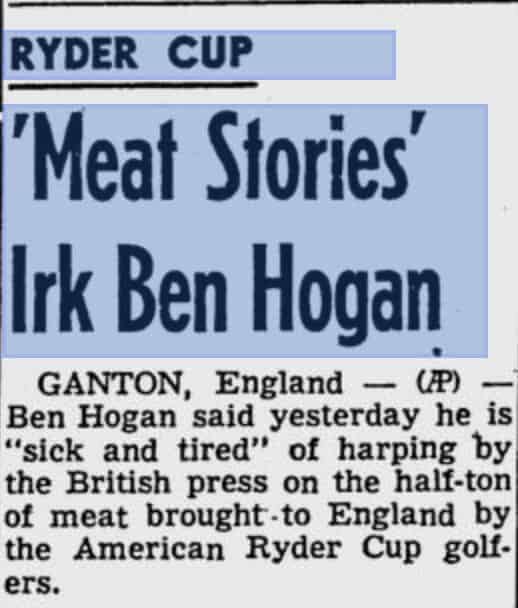
At that time, post-war Britain was in the grip of rationing. Limits, introduced on Jan 8, 1940, had been imposed on the sale of meat, clothing, petrol and flour. Bartering for extra food outside shops was a way of life. Restrictions were gradually lifted as the years went on but by the time the Americans arrived, only flour and clothes were no longer rationed.
Hogan had become aware of the shortage as he recovered from the car crash that famously almost cost him his life. Only months before the Ryder Cup, the man with a swing from the Gods had survived a head-on collision with a bus on a foggy February night in Texas. In throwing himself across his wife Valerie to protect her, Hogan had suffered a double-fracture of the pelvis, a fractured collarbone and left ankle, chipped ribs and blood clots. A surgeon was flown from New Orleans by an US Air Force plane to save his life.
From his hospital bed, Hogan prepared meticulously. He recruited an esteemed New York butcher to put 600 sirloin steaks, 12 sides of ribs, 12 hams and 12 boxes of bacon on board RMS Queen Elizabeth bound for Britain and the Ryder Cup.
GANTON IN RYDER CUP SPOTLIGHT
The Americans, who travelled with their wives, were to spend a month in England, not only to prepare fully for the Ryder Cup at Ganton but to play in the British Masters at St Andrews and the British PGA Matchplay at Walton Health, which boasted a winning cheque of £2,620
But, at first, it was the meat that made in the headlines. Reporters explained to Hogan the influx of food in their tightly rationed islands warranted headlines. “Maybe so,” he replied. “But you don’t go around every day printing what Lord so and so had for lunch, or tea or dinner. I don’t get your angle. Those steaks and hams have been in your papers for 12 days now. We bought it over for our own table and to entertain the British golfers and their wives.”
A PLACE IN GOLF FOLKLORE
If that was to be the first controversy of the 49′ Ryder Cup, it was not the last. Two years’ earlier at the 1947 Ryder Cup at Portland Golf Club, Hogan had been involved in a dispute over the depth of the grooves on his irons. On the last afternoon of practice, Henry Cotton, then British captain, had demanded the irons of Hogan and the American players be examined to see if they were legal. All passed inspection.

Hogan returned the favour at Ganton. Bernard Darwin, chairman of the R&A’s rules committee, was summoned from his pre-dinner bath, so the story goes, and agreed with Hogan, deciding that some irons did not conform to the rules leaving Ganton’s head pro, Jock Ballentine, to work through the night to file them down to a legal depth.
All of these stories add to the folklore of Ganton, add to the mystique and history which surrounds it. It’s a truly unique golfing destination.
A MOMENT TO REFLECT
Our day ends with a drink and a moment of quiet reflection in the clubhouse. Ganton Golf Club is a special place and not only because of its storied history. The Ryder Cup is just one chapter of it, there is much more to learn and understand. It is, quite frankly, hard to sum up in writing but all you need to know is that it is a genuine privilege to play golf here.
If you ever get the chance don’t pass it up.
GANTON GOLF CLUB: KEY FACTS
Phone Number: 01968 660970
Designers: Tom Chisholm, Robert Bird, James Braid, Alister MacKenzie, Harry Colt, John Henry Taylor, and Harry Vardon.
Green Fee Range: £130 to £55.
Length: Par 73 – 6739 Yards
Website: gantongolfclub.com




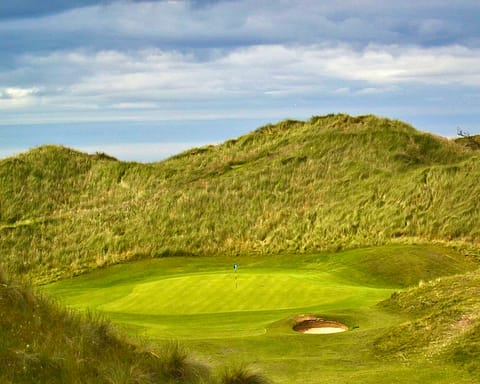
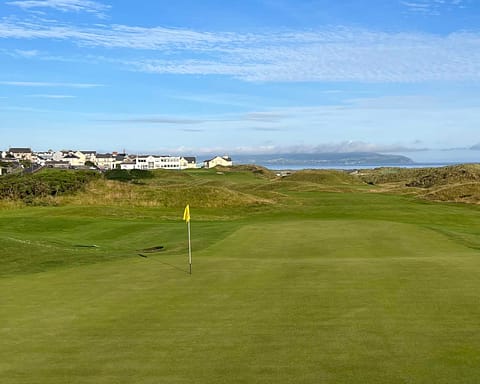


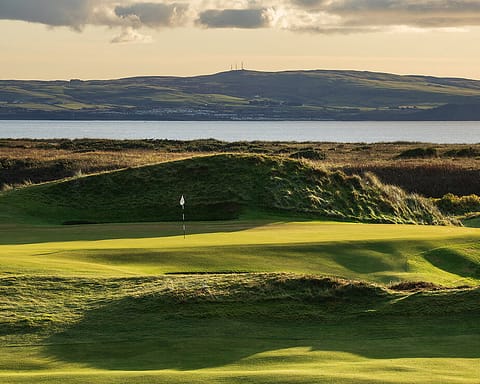
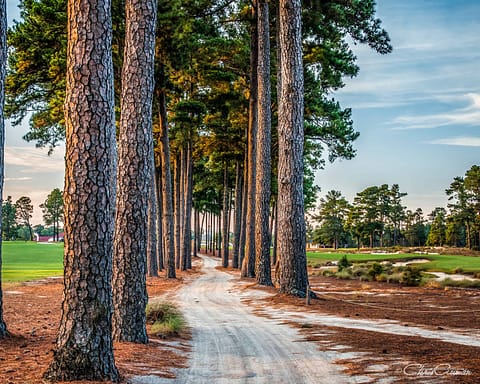
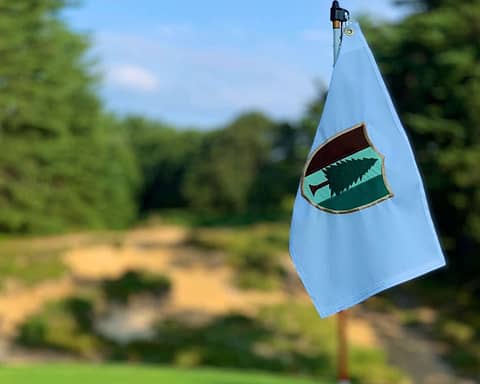
Loving the information in these articles, you have done outstanding job on these posts. Must visit this course!